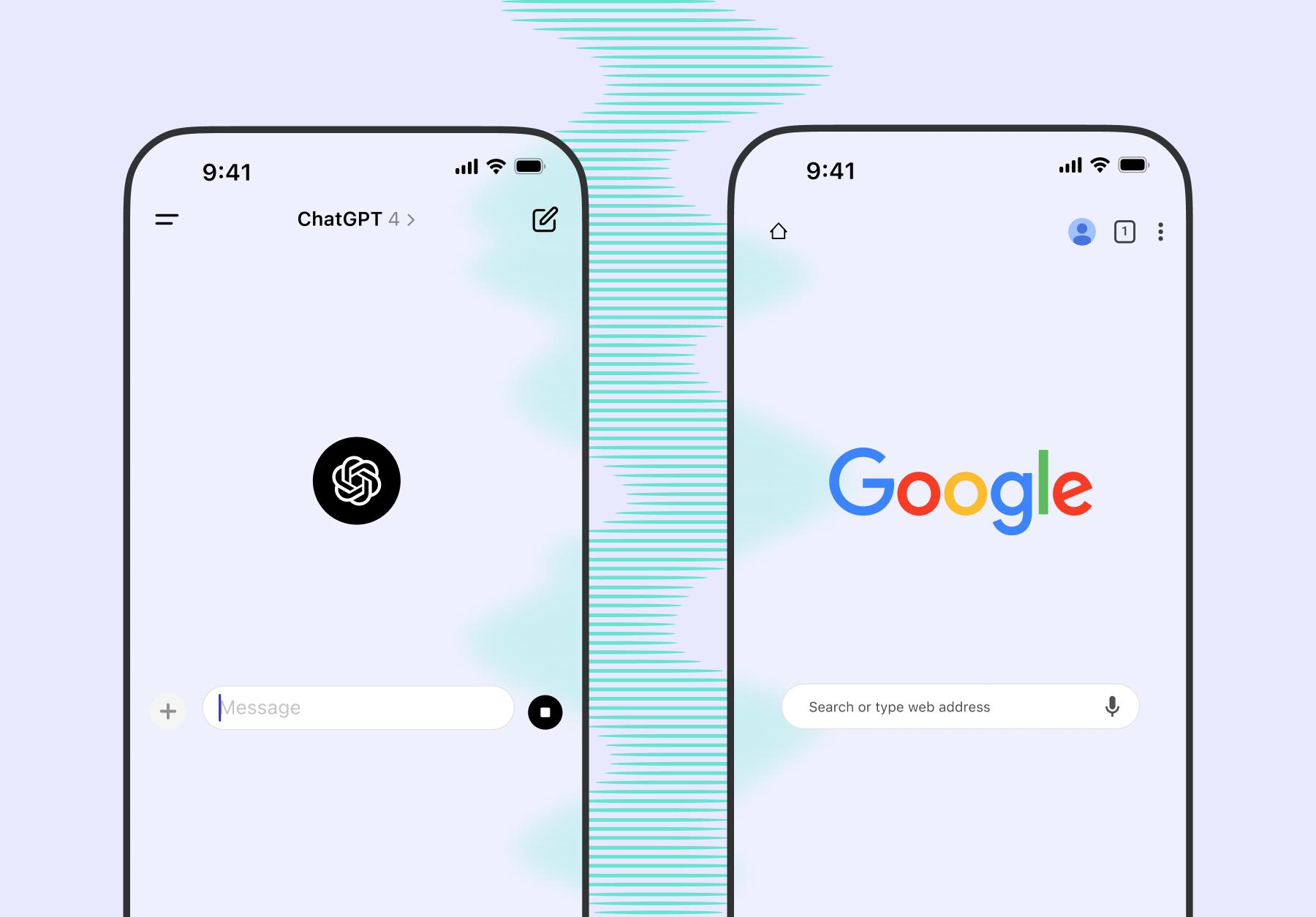Behind the algorithms: how AI chatbot recommendations work
AI chatbots like ChatGPT, Perplexity, and Copilot are rapidly emerging as new gateways to the internet, offering direct answers instead of traditional link lists. In this article, we help you figure out how their recommendations work – which is the first step to building an informed Generative Engine Optimization (GEO) strategy.

Not long ago, Google was the dominant channel for acquiring online traffic. Today, with the rise of large language models (LLMs) like GPT-4, Claude, or Gemini, users are increasingly turning to AI chatbots not only for conversations but also to search for products, services, and information. ChatGPT, Perplexity, and Copilot don’t just generate responses – they’re becoming new “gateways” to the internet. In this context, understanding how AI chatbot recommendations work is crucial for every online business owner.
AI Search instead of Google? A new user touchpoint
AI Search tools are rapidly gaining popularity. According to data from an Ahrefs report, 63% of websites record traffic from AI Search, and according to Master.Of.Code, 64% of customers declare willingness to purchase products recommended by AI.

This means one thing: chatbots like ChatGPT are becoming a real source of valuable, converted traffic. Although Google still dominates the majority of online traffic, with the current pace of development, we can expect the share of AI Search to grow rapidly. As a result, if your brand doesn’t appear in AI-generated responses – it may simply be unknown to many users.
The takeaway? Just as we once optimized websites for SEO, today we must think about GEO – Generative Engine Optimization. This new paradigm isn’t about ranking in Google, but about presence in AI-generated answers. To optimize your content for visibility in chatbots, you must first understand how they work.
What should you know about how AI chatbots work?
AI chatbots like ChatGPT, Perplexity, or Copilot are not just conversational tools – they’re intelligent search interfaces. Unlike traditional search engines that return a ranked list of links, AI chatbots generate direct answers by synthesizing information from various sources and matching it to the context of the query. They operate based on large language models (LLMs), which “learn” language and knowledge from massive datasets: texts, articles, forums, product descriptions, and technical documentation.
Their key advantage is understanding user intent – chatbots don’t look for keyword matches but instead try to respond precisely to the query, considering the conversation context, question style, and even previous interactions. This allows them to not only provide information but also recommend specific products, services, or solutions – just like a consultant or salesperson would.
This new interaction model changes the logic of search: users don’t need to browse dozens of result pages – the answer, suggestion, or recommendation appears instantly in the chat window. That’s why understanding the mechanisms behind AI Search is crucial – not only for SEO experts but also for brand owners who want their content to appear in AI-generated recommendations.

How do AI chatbot recommendations work?
AI chatbot recommendations are not random suggestions – they result from complex mechanisms combining artificial intelligence, language analysis, and contextual data. Here are the five key pillars of the process:
1. Natural language processing (NLP) and intent recognition
Every interaction starts with processing the user’s query – not just its literal form, but its underlying intent. Thanks to advanced NLP algorithms, the chatbot:
- Recognizes keywords and entities (e.g., brands, products, features)
- Interprets user intent (e.g., advice, purchase, comparison)
- Analyzes tone, style, and conversation context
Unlike traditional search engines, AI doesn’t look for keyword matches – it tries to understand what the user really wants, just like a human would.
2. Recommendation systems: collaborative and content-based filtering
Once the chatbot understands the query, it begins generating suggestions. It uses recommendation systems based on two main techniques:
Collaborative filtering
- Analyzes behavior and choices of other users with similar needs.
- Predicts what might appeal to a given user using “collective intelligence.”
Content-based filtering
- Matches recommendations based on the features of searched products or services (e.g., material, style, function).
- Considers the user’s past choices and their common traits.
Hybrid systems often combine both approaches to ensure more accurate recommendations.
3. Personalization and conversational memory
Next-gen chatbots can learn about the user in real time. If the user previously mentioned:
- Style preferences (e.g., minimalism)
- Favorite brands
- Budget or needs (e.g., eco-friendly products)
the model remembers this information and tailors future recommendations accordingly. In ChatGPT, this feature is called “memory” and allows the model to consider past conversations even after a long time.
4. Integration with knowledge bases and external data
Chatbots are not limited to built-in knowledge. When operating in browsing mode, they pull data from current sources:
- Product catalogs and online store websites
- Reviews and ratings (e.g., Trustpilot, G2)
- Industry blogs, comparisons, reports
- Forums and social platforms (e.g., Reddit, Quora)
Importantly, chatbots like Perplexity or Copilot display the sources they reference, increasing the transparency of recommendations.
5. Learning from interaction
Every chatbot conversation also serves as real-time training data. Models learn:
- Which recommendations are clicked and accepted
- What is ignored or requires clarification
- Which questions are frequently repeated
Over time, the model identifies behavioral patterns and user preferences more and more precisely, allowing for more accurate predictions. This is a continuous improvement process – similar to personalization, but working on a collective (global) level.
Thanks to these five pillars, AI chatbots can recommend products, services, or content with accuracy close to that of a sales advisor – doing so in real time, in a conversational and user-friendly manner. That’s why AI Search is becoming a vital new channel for reaching customers.
AI chatbot recommendations in a real-life example
To better understand how AI Search recommendations work, let’s look at an example query:
“I’m looking for elegant men’s winter shoes, preferably with a leather sole.”
This simple statement triggers a complex chain of processes within an AI chatbot:
1. NLP and intent recognition
The model analyzes the query:
- Product type: winter shoes
- Style: elegant
- Gender: male
- Specific preference: leather sole
Instead of looking for keyword matches, the chatbot tries to understand the goal. In this case: to find stylish, warm winter shoes that match a coat or suit.
2. Personalization (if memory or context is active)
If the chatbot has previously gathered user info (e.g., brand preferences, price range, color, previous searches), it can use it now. For example:
- “You prefer classic styles” → priority to Oxfords or Derbies
- “You previously asked about Loake and Berwick shoes” → more likely to recommend those brands
3. Integration with databases and source analysis
The chatbot uses real-time data – from integrated store catalogs, comparison sites (like Ceneo, Zalando), fashion blogs, or forums. In browsing mode, it checks:
- Whether the product is available
- What reviews it has
- Price
- If it matches the criteria (e.g., leather sole)
It may also use opinion sites (e.g., Trustpilot, G2) or expert reviews.
4. Selection and presentation of the recommendation
Based on collected data, the chatbot prepares a personalized answer. For example:
“I recommend the Berwick 3010 Winter model—a classic Derby shoe made of full-grain leather, with a Dainite rubber sole and Thinsulate insulation. Perfect for city conditions, combining elegance and functionality.”
The chatbot may add a store link, describe alternatives (e.g., “a cheaper alternative with similar style is…”), or ask follow-up questions: color, budget, boot height.
5. Interactive refinement and learning
The user may respond with:
- “Are they available in cognac color?”
- “Anything cheaper?”
- “I don’t like rubber soles – anything more traditional?”
Based on this, the chatbot adjusts the recommendation in real time – narrowing down options, analyzing new criteria, and learning user preferences for the future.
What does this mean for website owners?
AI Search doesn’t work like classic SEO – while the factors that influence Google ranking often overlap with those that determine visibility in AI Search, the approach is different. So how do you create content that generates traffic from chatbots?
- Focus on entities, not just keywords
- Write for embeddings, not only SEO
- Create semantic connections
- Match style and format to AI response patterns
More details about optimization for AI Search can be found in our article:

Summary
In 2025, brand visibility doesn’t stop at the first page of Google. In the age of AI Search, what matters is whether chatbots like ChatGPT, Perplexity, or Copilot cite your content as a trustworthy source. These bots increasingly answer users’ questions.
AI-generated recommendations stem from five components: natural language analysis, recommendation systems, personalization, data integration, and continuous learning from interaction. For your brand to be included, your content must be:
- Semantically clear,
- Contextual and conversational,
- Rich in entities and thematic connections,
- Technically accessible and easy for language models to process.
Generative Engine Optimization (GEO) doesn’t replace SEO – it complements it where users seek answers, not links. Brands that start implementing GEO now will build a competitive edge that may prove invaluable in the near future.



